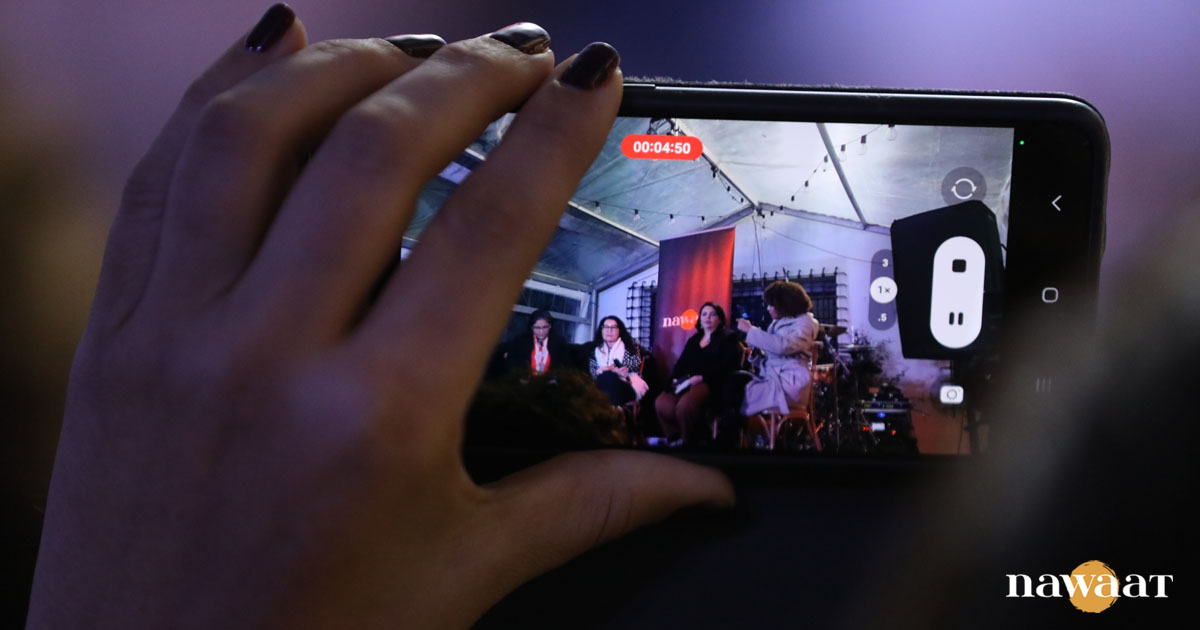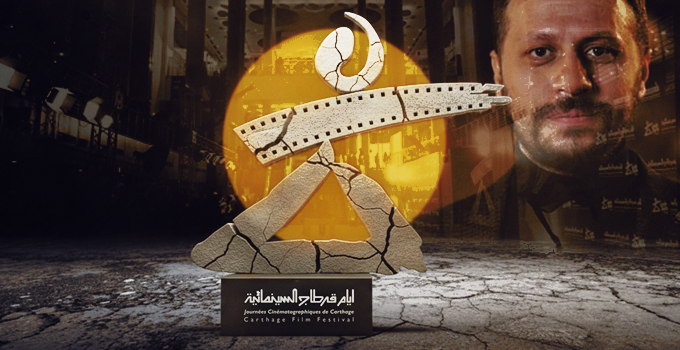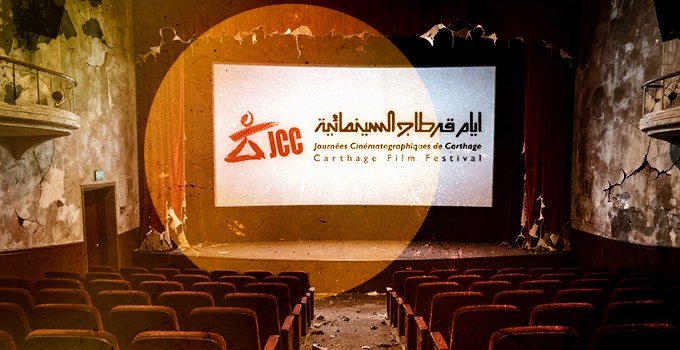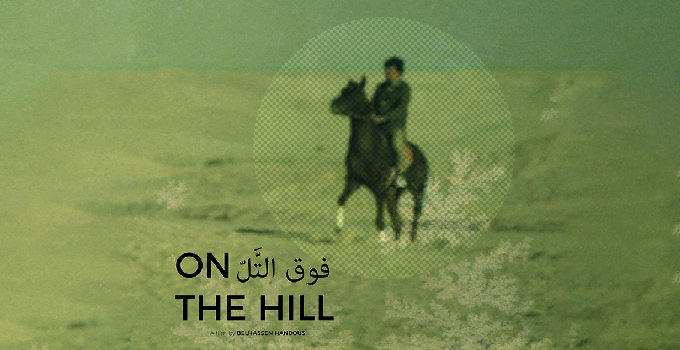From December 15-17, Nawaat Festival held its third edition in Tunis. Founded in 2004, Nawaat remains one of the country’s rare independent media outlets. Like Orient XXI, Nawaat is a member of the Independent Media on the Arab World network.
Nawaat hosted the event at its own splendid headquarters near downtown Tunis, a villa once owned by Wassila Bourguiba, second wife of the former president Habib Bourguiba. Several hundred participants attended the festival, a panoply of debates and dance in the garden, immersion into the hip hop scene with the collective Room 95, the screening of Palestinian film archives, and works by photographer Chehine Dhahak.

Dhahak’s exhibition Vagabondage explores the theme of wandering. Through stolen portraits, images of isolated solitudes sand marginal landscapes, one literally wanders between urban and suburban photographs that isolate the captured moment, much like the fleeting silhouettes featured in these secondary spaces. Anonymity and absence form the essence of a sensitive errantry. The titles “Easy rider,” “Tree of Life,” “A kind of blue,” and “Just do it,” frame within a sort of dark humor the bodies and humanized fringes of the post-revolution Tunisia explored through Dhahak’s camera lens.
Political bodies
Throughout the festival, the theme of resistance was explored through bodies. Bodies that resist—including against themselves, in the dance performance Bon deuil!! by Feteh Khiari and Houcem Bouakroucha, with music by Ayoub Bouzidi.

Between suffering and complicity, the young contemporary dancers seek to escape their state/State, transmitting through their movements both revolutionary aspirations and collective disillusionment. The body at once exudes and conceals frustrations of even the most political nature. And yet, in the empty swimming pool at Nawaat’s headquarters where the performance took place, these young Tunisians did not drown in despair. They escaped, together, on a soul chorus. The dark optimism conveyed by these artists is preceded by the title of their performance…

Optimism is also what enables different artists to find a space and time for self-expression thanks to the festival, even as the country’s Ministry of Cultural Affairs is stifled by a meager budget, and the regional context bears a significant impact upon artistic life on the ground. In his experimental short film Memories of Concrete, Yasser Jridi films the central market, focusing on repetitive tasks, daily contradictions and the futile promises of democracy. Here again, the viewer beholds bodies in movement, animated by jerky dialogues and surreal imagery.
But the festival could not turn a blind eye to the tragedy that has unfolded in the Gaza Strip. And so the collective Journées du cinéma de la résistance found its place in the limelight. Created following the suspension of the country’s Journées cinématographiques de Carthage (Carthage Film Festival), the collective organizes outdoor film screenings. The most recent, held in solidarity with Palestine, were projected onto the wall of the French Institute of Tunis, today graffitied with proclamations of support for Palestine, and of opposition to colonization and Macron. During the three-day festival, the collective was invited to screen a selection of films in Nawaat’s underground level.
The selection included a filmed interview with writer and Popular Front for the Liberation of Palestine (PFLP) activist Ghassan Kanafani, focusing on the search for justice in the Israel-Palestine conflict. Kanafani refutes the term “conflict”, preferring “national liberation movement for rights.” Director Hani Jawharieh, one of the founders of the Palestine Film Unit (who died in 1976 while filming the resistance), also had his place among the archives selected. Scènes d’occupation à Gaza [Scenes of occupation in Gaza] by Moustafa Abou Ali shows us that, already in 1973, Gaza residents were the most feared by the Israeli army and that, since the occupation of the Gaza strip in 1967, more than 10,000 individuals had been imprisoned, some facing a 300-year sentence. Beyond the clearly documented humiliation faced by Palestinians on a daily basis, the agenda to evacuate the population to Sinai and the West Bank was already underway. Finally, Les Femmes palestiniennes [Palestinian Women] by Jocelyne Saab (1973) shines a light on the fervor of fedayin (fida’iyat) militants. In a documentary sequence filmed half a century ago, one of them asserts that it is also “the United States and France who are waging war on us.” Will the emancipation of women under the occupation—but also within the patriarchy—be achieved through armed struggle?

This resistance of memories does not leave the Amazigh by the wayside. In his virtual reality film Les Amazighs, Mémoires perdues [Amazigh, Lost Memories] produced by Nawaat, Mohamed Arbi Soualhia seeks to preserve Amazigh collective memory. Between the villages of Zraoua and Tamezret, he archives the architecture of troglodyte tunnels as well as the local language in the face of the exodus of local populations due to political and climatic changes.
Femicide
Debate during the festival also focused on women’s rights, between violence and resistance. The starting point for discussion was the mass femicide in Gaza which has entailed the killing of 6,500 women since the beginning of the offensive, not to mention the deplorable sanitary conditions in which 50,000 women have been forced to give birth.

Nabila Hamza, member of the executive bureau of the Tunisian Association of Women Democrats (ATFD), highlighted the four-fold increase in violence against women since 2022 with the murder of 27 women. Without an exact equivalent of the term “femicide” in Arabic, the ATFD created a mapping entitled La Tunisie des femmes tuées [Tunisia’s Murdered Women]. The Association held a moot court as a means of data collection, but also “in order to honor the memory of these women and tell their story.”
Forms of violence against women are, as everywhere else, diverse. They are primarily committed by family members, especially husbands or ex-husbands, and extend into the cyber world. This phenomenon is above all political and social, and touches all segments of society. As Nabila Hamza, a sociologist, points out, murder is the result of a “continuum of acts of violence” that go unnoticed by family members as well as the authorities.
Sondés Garbouj, a psychologist specialized in gender-based violence, recalls that Tunisia does have a legal text in place to address the issue. Law 2017 concerning the elimination of violence against women, while touted by international organizations, remains ineffective due both to a lack of means and the failure, by citizens and civil servants alike, to appropriate the framework. Grounded in a tradition of state feminism that was heralded by former president Habib Bourguiba, the law does not address underlying social issues, such as the economic inequalities that pervade matters of inheritance.
Powerful personal story
For journalist Rim Saoudi, “if society is ill, it is partly because of how the media has addressed these issues,” which have always featured as news items of secondary interest. A trend that is exacerbated by the normalization of inappropriately patriarchal terms such as “honor crimes” or “crimes of passion,” expressions devoid of meaning which fail to convey the possessive character of violence committed.
Discussions also evoked the racist and xenophobic remarks made by President Kais Saied which set off a wave of violence targeting black migrants in the beginning of 2023. Again, it was the women among this population of immigrants who were most affected by the violence that ensued. The personal story shared by Edwige from Cameroon was by far the most powerful moment of the debate. Raped multiple times during her journey, including by Algerian and Tunisian border guards, Edwige is today economically exploited in Tunisia and faces racism on a daily basis. In the meantime, she continues to experience sexual harassment, especially by taxi drivers.

Finally, the kinetic movement which animated the festival followed the eclectic sounds and rhythms by Tunisian artist Don Pac. Event goers danced to the beats of his first album, Fashion WeAk, which draws from classic archives as well as blues, Afromusic, hip hop and reggae. But it was certainly Widad Mjama who most electrified the atmosphere beneath heavy sheets of rain. Inspired by the cries of sheikhats from Morocco’s western region of Abda and their rebellious poems sung since the 12th century, Mjama, pioneer of women’s rap in Morocco, presented her newest creation Aita mon amour along with Tunisian composer Khalil Hentati (EPI). Mjama’s vocals not only set bodies into motion, but also move souls and combat gender-based discrimination.

In its fight to sustain a space for freedom and expression—an endeavor carried forth on the shoulders of a dedicated team of journalists—Nawaat has kept good on its promises. Let us hope that this culture of resistance will carry through well into the summer months for the next installment of Nawaat Festival, which clearly represents a platform for the art and activism of today’s Tunisian youth.
This article is a translation of an original work published on Orient XXI website.





iThere are no comments
Add yours